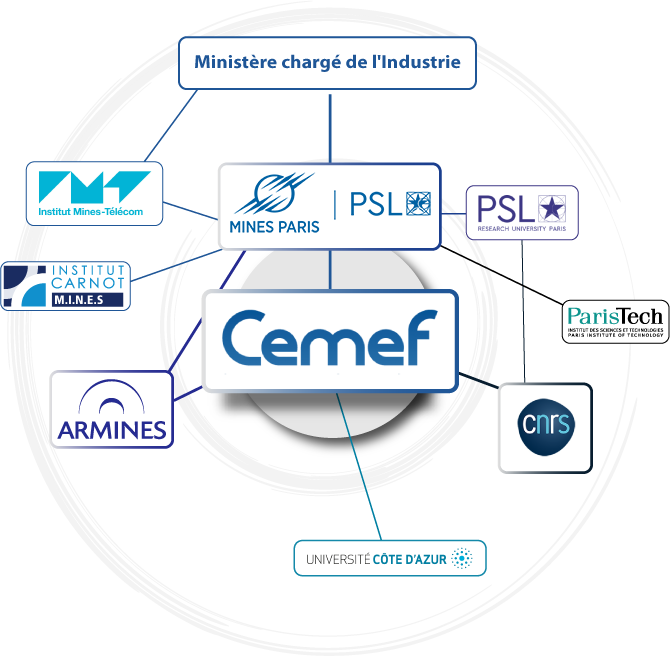Environment & organization
External academic structure and internal structure of the centre

The academic landscape in which CEMEF operates is a direct result of the organisation and structure of the academic bodies to which it belongs.
Its two supervisory bodies, Mines Paris and CNRS, are very active in their networks. As illustrated in the diagram, the main links formed by CEMEF's academic structure are numerous and important.
CEMEF also bases its internal organisation on its research teams.

ACADEMIC STRUCTURE
The CEMEF is one of the 18 research centres of Mines Paris. It is also a Joint Research Unit (UMR7635) of the CNRS . At the same time, the association ARMINES, participates in the partnership research of MINES ParisTech, provides its own resources (human and material) and is in charge of the administrative and financial management of the centre's contracts.
Mines Paris depends, in the first instance, on the Ministry of Industry. The school is also involved in many organisations. Currently, it is involved in :
- University PSL, Paris Sciences et Lettres as a founding member
- ParisTech (cooperation network of 10 engineering schools) of which it is a founding member
- Conference des Grandes Ecoles (The CGE brings together most of the major engineering and business schools in France)
- M.I.N.E.S. Carnot Institute
- UCA, Université Côte d'Azur, as an associate member
- Institut Mines Telecom with which it is associated.
Internally, MINES ParisTech has structured its research into themes that are recognised as future challenges. To this end, it has created 5 departments. Our centre therefore belongs to the "Mechanics and Materials" department.
As far as CNRS is concerned, scientific policy is carried out by the institutes. There are 10 of them. They coordinate the actions of the centres. Thus, because of its multidisciplinary activities, CEMEF is part of two institutes:
- CNRS INGENIERIE (Institute of Engineering and Systems Science, section 9)
- CNRS CHIMIE (Institute of Chemistry, sections 11 and 15).
Please note: in addition to the activities of its supervisory bodies, CEMEF researchers are involved in the governance bodies of the Université Côte d'Azur.
CEMEF ORGANIZATION
Finally, the centre's internal organization is based on its research and training activities.
It is headed by Elie Hachem, Director. Research is organised into 4 divisions and 7 teams. Each course, whether a doctoral speciality or a Specialised Master's degree, is led by a scientist.
80
worlwide
collaborations
with
research laboratories
10
participations / coordinations
of GDRs,
French Research Groups
+20
participations in
learned societies
Scientific Councils &
Boards of Directors

